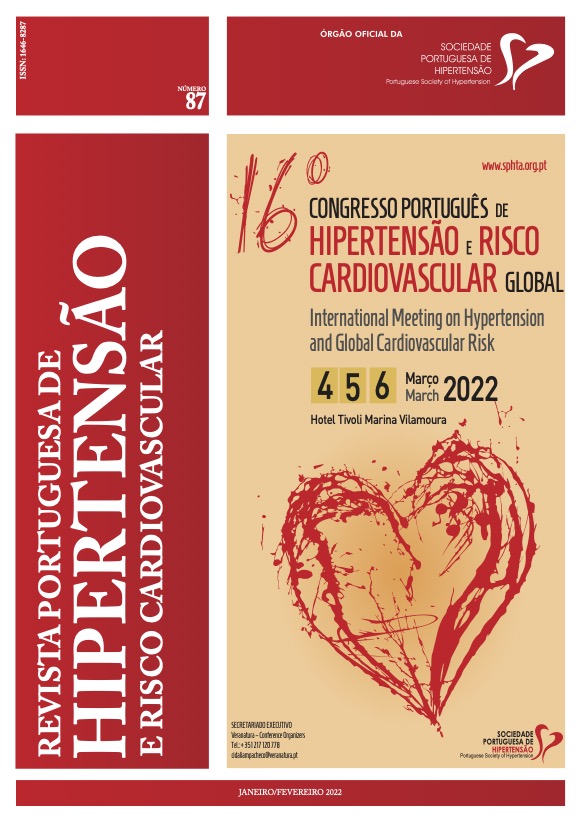AMBULATORY BLOOD PRESSURE MONITORING IN PRIMARY CARE – DIAGNOSTIC REALITY OF ARTERIAL HYPERTENSION
DOI:
https://doi.org/10.58043/rphrc.3Abstract
Introduction: Arterial hypertension is associated with high morbidity and mortality, with its prevalence estimated in Portugal at 29.1%. Blood pressure (BP) measurements in office and out-of-office are essential to confirm diagnosis. The 24-hour Ambulatory Blood Pressure Monitoring (ABPM) presents itself as the gold standard, being one of the advantages versus office measurements being the identification of white and masked hypertension. However, this exam is of limited access in Primary Care (PC), so the Health Unit (HU) of São Julião purchased equipment and started to perform this exam free of charge.Objectives: To determine the profile of results and diagnoses obtained after the ABPM.
Methods: Observational, descriptive, and cross-sectional study. Data were collected from ABPM related interviews at HU São Julião during 2019. According to the existence of antihypertensive therapy, we analyzed the BP values in the office and ABPM, making the diagnosis based on the guidelines of the European Society of Hypertension.
Results: From 46 ABPM, 43 valid exams were included. Of the 21 ABPM performed on users without antihypertensive therapy, we identified 90.5% of hypertension and 9.5% of normotensive individuals. In individuals with hypertension, the majority presented sustained hypertension (63.5%), 21.1% white coat hypertension and 15.7% masked hypertension. In users with antihypertensive therapy, it was found that about 68.2% uncontrolled hypertension. Of these 46.6% had uncontrolled white coat hypertension, 26.7% uncontrolled masked hypertension and 26.7% sustained uncontrolled hypertension.
Discussion: Similar to other studies, the studied population had a significant prevalence of white coat and masked hypertension, in individuals with or without antihypertensive treatment. These data may influence clinical practice and demonstrate the added value of accessing ABPM in PC.
Downloads
References
Stanaway JD, Afshin A, Gakidou E, Lim SS, Abate D, Abate KH, et al. Global, regional, and national comparative risk assessment of 84 behavioural, environmental and occupational, and metabolic risks or clusters of risks for 195 countries and territories, 1990–2017: a systematic analysis for the Global Burden of Disease Study 2017. The Lancet. Novembro de 2018;392(10159):1923–94.
Wilson PWF. Established Risk Factors and Coronary Artery Disease: The Framingham Study. Am J Hypertens. Julho de 1994;7(7_Pt_2):7S-12S.
Lawes CM, Hoorn SV, Rodgers A. Global burden of blood-pressure-related disease, 2001. The Lancet. Maio de 2008;371(9623):1513–8.
Macedo ME, Ferreira RC. A Hipertensão Arterial nos Cuidados de Saúde Primários, em Portugal: contibuto para o conhecimento epidemiológico da população em 2013. Revista de Factores de Risco. 2015;(36):47–56.
Mancia G, Rosei EA, Azizi M, Burnier M, Clement DL, Coca A, et al. 2018 ESC/ESH Guidelines for the management of arterial hypertension.
;98.
Piper MA, Evans CV, Burda BU, Margolis KL, O’Connor E, Whitlock EP. Diagnostic and Predictive Accuracy of Blood Pressure Screening Methods With Consideration of Rescreening Intervals: A Systematic Review for the U.S. Preventive Services Task Force. Ann Intern Med. 3 de Fevereiro de 2015;162(3):192.
Hinneburg I. [Common errors in blood pressure monitoring]. Med Monatsschr Pharm. Setembro de 2013;36(9):320–3.
Mesquita-Bastos J, Bertoquini S, Polónia J. Cardiovascular prognostic value of ambulatory blood pressure monitoring in a Portuguese hypertensive population followed up for 8.2 years: Blood Press Monit. Outubro de 2010;15(5):240–6.
Salles GF, Leite NC, Pereira BB, Nascimento EM, Cardoso CRL. Prognostic impact of clinic and ambulatory blood pressure components in high-risk type 2 diabetic patients: the Rio de Janeiro Type 2 Diabetes Cohort Study. J Hypertens. Novembro de 2013;31(11):2176–86.
Dolan E, Stanton A, Thijs L, Hinedi K, Atkins N, McClory S, et al. Superiority of Ambulatory Over Clinic Blood Pressure Measurement in Predicting Mortality: The Dublin Outcome Study. Hypertension. Julho de 2005;46(1):156–61.
Yang W-Y, Melgarejo JD, Thijs L, Zhang Z-Y, Boggia J, Wei F-F, et al. Association of Office and Ambulatory Blood Pressure With Mortality and Cardiovascular Outcomes. JAMA. 6 de Agosto de 2019;322(5):409.
Banegas JR, Ruilope LM, de la Sierra A, Vinyoles E, Gorostidi M, de la Cruz JJ, et al. Relationship between Clinic and Ambulatory Blood- Pressure Measurements and Mortality. N Engl J Med. 19 de Abril de 2018;378(16):1509–20.
Fagard RH, Cornelissen VA. Incidence of cardiovascular events in white- coat, masked and sustained hypertension versus true normotension: a meta-analysis: J Hypertens. Novembro de 2007;25(11):2193–8.
Franklin SS, Thijs L, Hansen TW, Li Y, Boggia J, Kikuya M, et al. Significance of White-Coat Hypertension in Older Persons With Isolated Systolic Hypertension: A Meta-Analysis Using the International Database on Ambulatory Blood Pressure Monitoring in Relation to Cardiovascular Outcomes Population. Hypertension. Março de 2012;59(3):564–71.
Mancia G, Verdecchia P. Clinical Value of Ambulatory Blood Pressure: Evidence and Limits. Circ Res. 13 de Março de 2015;116(6):1034–45.
O’Brien E, Asmar R, Beilin L, Imai Y, Mallion J-M, Mancia G, et al. European Society of Hypertension recommendations for conventional, ambulatory and home blood pressure measurement: J Hypertens. Maio de 2003;21(5):821–48.
de Greeff A, Shennan AH. Validation of the Spacelabs 90227 OnTrak device according to the European and British Hypertension Societies as well as the American protocols: Blood Press Monit. Dezembro de 2019;1.
Parati G, Stergiou G, O’Brien E, Asmar R, Beilin L, Bilo G, et al. European Society of Hypertension practice guidelines for ambulatory blood pressure monitoring: J Hypertens. Julho de 2014;32(7):1359–66.
Grin JM. Management of Hypertension after Ambulatory Blood Pressure Monitoring. Ann Intern Med. 1 de Junho de 1993;118(11):833.
Krakoff LR, Eison H, Phillips RH, Leiman SJ, Steven Lev. Effect of ambulatory blood pressure monitoring on the diagnosis and cost of treatment for mild hypertension. Am Heart J. Outubro de 1988;116(4):1152–4.
Krakoff LR. Cost-Effectiveness of Ambulatory Blood Pressure: A Reanalysis. Hypertension. Janeiro de 2006;47(1):29–34.





